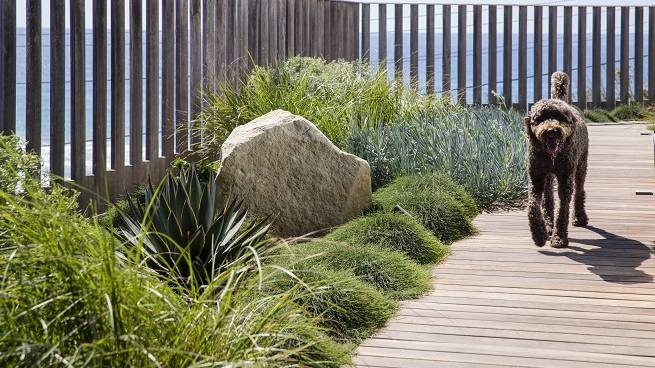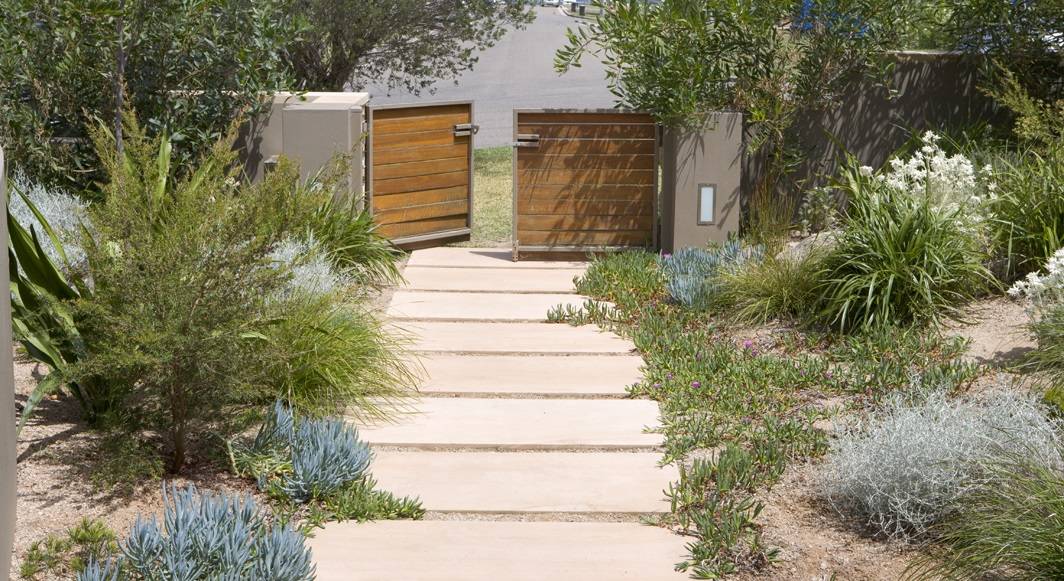As drought conditions continue across many parts of Australia, many property owners are contemplating water-wise options for outdoor spaces.
“Whether it’s in the garden, pool or areas in between, there are plenty of ways to create beautiful and practical outdoor spaces that are also low on maintenance and water requirements,” landscape designer Matt Leacy, from Landart Landscapes, said.
“It’s all about knowing what your options are and making smart choices. Water restrictions don’t necessarily have to mean sacrificing outdoor style, aesthetic and use.”
Here are Matt’s top tips for year-round water-wise landscaping.
Water-wise plantings and lawns
“In drought or very dry periods, it’s best to have plants that are hardy and can cope in sunny conditions with minimal water,” Matt says.
“At the same time, you ideally want to select drought-resistant plants that are consistent with your intended garden style and aesthetic – and the soil you’re working with,” he said.

Water restrictions don’t necessarily have to mean sacrificing outdoor style, aesthetic and use
“If you’re a big fan of colour, you might opt for the likes of acacia (‘wattles’), succulents, and Rhaphiolepis (‘Apple Blossoms’),” Matt said.
“Succulents, in particular, are some of the most versatile water-wise choices. Carpobrotus, Senecio, Sempervivums, Crassula, Aloes and Sedums are all very unique and come in a variety of colours, textures, shapes and sizes.
“If your goal is to bring more structure into the garden, you might choose architectural plants like tree aloes, dragon trees, Nolina’s, agaves or cactuses,” Matt said.
“If you’re looking to fill a large space with mass plantings, you might consider ornamental grasses and low-maintenance varieties like Lomandra,Echiums, Westringias, Casurinas and, again, succulents.
“In terms of native water-wise choices, some of my favourities include Correa alba (‘white correra’), Leucophyta brownie (‘Cushion Bush’), Adenanthos sericeus (‘Woolly Bush’) and Hibbertia scandens (‘snake vine’), to name just a few.”
Matt said that for the best type of water-wise lawn, you can’t go past soft leaf Buffalo Grass, like Sapphire or Sir Walter. He said these cope better with less water compared to other types of grasses. They will brown if they go a long time without water, but they also bounce back pretty quick after rainfall. Make sure you fertilise Buffalo Grass, as well as aerate and irrigate it properly.
“In the warmer months when the grass is growing, I would always recommend giving your lawn at least two deep root soakings per week in the morning before 10am,” Matt said. “You’ll get much better results than, say, giving the lawn five light sprinklings over the course of a week.”

Fill a large spaces with mass plantings of ornamental grasses and low-maintenance varieties like Lomandra,Echiums, Westringias, Casurinas and succulents.
Drip Irrigation systems
Matt said drip irrigation systems remain one of the most efficient ways to get water into the garden, and they are permitted for use in all state and territories.
“There are many types of drip irrigation systems on the market, which can be suited to different property sizes and budgets – the most simple of which are battery-operated systems.
“If you don’t have a lot of time for garden maintenance, I’d recommend an automated drip irrigation system,” Matt said.
“These can be set with a timer to turn on and off automatically whenever you want them to. I’d suggest setting the timer to turn the system on early in the morning as this will reduce overall evaporation and give plants a solid kick-start to the day. Under the new water restrictions, all irrigation systems must have a rain gauge or soil moisture sensor.
“It’s also worth noting that drip irrigation systems run underneath mulch, so it’s best to install them before you begin the mulching process.”
Mulching is important in boosting the water efficiency of any garden because it helps to conserve moisture, insulate the soil and reduce weeds.
“As a general rule, it’s best to mulch at least 50-70mm deep and to keep the mulch away from the stems of trunks or plants,” Matt said.
“And make sure you to follow the mulch application instructions properly as you can reduce the available water to the soil if you get the mulch and depth wrong.
“In terms of mulch varieties, this depends on the soil type and plants used – though generally a decomposed pine bark works well, though it will need topping up more regularly. It ultimately comes down to what your soil needs and what you are trying to achieve.”
